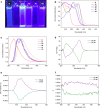Enantioselective construction of six- and seven-membered triorgano-substituted silicon-stereogenic heterocycles
- PMID: 33623025
- PMCID: PMC7902825
- DOI: 10.1038/s41467-021-21489-6
Enantioselective construction of six- and seven-membered triorgano-substituted silicon-stereogenic heterocycles
Abstract
The exploitation of chirality at silicon in asymmetric catalysis is one of the most intriguing and challenging tasks in synthetic chemistry. In particular, construction of enantioenriched mediem-sized silicon-stereogenic heterocycles is highly attractive, given the increasing demand for the synthesis of novel functional-materials-oriented silicon-bridged compounds. Here, we report a rhodium-catalyzed enantioselective construction of six- and seven-membered triorgano-substituted silicon-stereogenic heterocycles. This process undergoes a direct dehydrogenative C-H silylation, giving access to a wide range of triorgano-substituted silicon-stereogenic heterocycles in good to excellent yields and enantioselectivities, that significantly enlarge the chemical space of the silicon-centered chiral molecules. Further elaboration of the chiral monohydrosilane product delivers various corresponding tetraorgano-substituted silicon-stereogenic heterocycles without the loss of enantiopurity. These silicon-bridged heterocycles exhibit bright blue fluorescence, which would have potential application prospects in organic optoelectronic materials.
Conflict of interest statement
The authors declare no competing interests.
Figures






References
-
- Dubac J, Laporterie A, Manuel G. Group 14 metalloles. 1. Synthesis, organic chemistry, and physicochemical data. Chem. Rev. 1990;90:215–263. doi: 10.1021/cr00099a008. - DOI
-
- Hissler M, Dyer PW, Reau R. Linear organic π-conjugated systems featuring the heavy Group 14 and 15 elements. Coord. Chem. Rev. 2003;244:1–44. doi: 10.1016/S0010-8545(03)00098-5. - DOI
-
- Chen J, Cao Y. Silole-containing polymers: chemistry and optoelectronic properties. Macromol. Rapid Commun. 2007;28:1714–1742. doi: 10.1002/marc.200700326. - DOI
-
- Ohshita J. Conjugated oligomers and polymers containing dithienosilole units. Macromol. Chem. Phys. 2009;210:1360–1370. doi: 10.1002/macp.200900180. - DOI
-
- Wong WWH, Hooper JF, Holmes AB. Silicon analogues of polyfluorene as materials for organic electronics. Aust. J. Chem. 2009;62:393–401. doi: 10.1071/CH08497. - DOI
Publication types
LinkOut - more resources
Full Text Sources
Other Literature Sources

